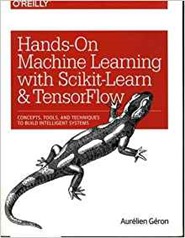 I’ve recently started playing around with recurrent neural networks and tensorflow which brought me to Hands-on machine learning with scikit-learn & tensorflow by Aurélien Géron, as a bonus it also includes material on scikit-learn which I’ve been using for a while.
I’ve recently started playing around with recurrent neural networks and tensorflow which brought me to Hands-on machine learning with scikit-learn & tensorflow by Aurélien Géron, as a bonus it also includes material on scikit-learn which I’ve been using for a while.
The book is divided into two parts, the first, “Fundamentals of Machine Learning” focuses on the functionality which is found in the scikit-learn library. It starts with a big picture, running through the types of machine learning which exist (supervised / unsupervised, batched / online and instance / model) and then some of the pitfalls and problems with machine learning before a section on testing and validation. The next part is a medium sized example of machine learning in action which demonstrates how the functionality of scikit-learn can be quickly used to develop predictions of house prices in California based on census data. This is a subject after my own heart, I’ve been working property data in the UK for the past couple of years.
This example serves two purposes, firstly it demonstrates the practical steps you need to take when undertaking a machine learning exercise and secondly it highlights just how concisely much of it can be executed in scikit-learn. The following chapters then go into more depth first about how models are trained and scored and then going into the details of different algorithms such as Support Vector Machines and Decision Trees. This part finishes with a chapter on ensemble methods.
Although the chapters contain some maths, their strength is in the clear explanations of the methods described. I particularly liked the chapter on ensemble methods. They also demonstrate how consistent the scikit-learn library is in its interfaces. I knew that I could switch algorithms very easily with scikit-learn but I hadn’t fully appreciated how the libraries generally handled regression and multi-class classification so seamlessly.
I wonder whether outside data science it is perceived that data scientists write their own algorithms from scratch. In practical terms it is not the case, and hasn’t been the case since at least the early nineties when I started data analysis which looks very similar to the machine learning based analysis I do today. In those days we used the NAG numerical library, Numerical Recipes in FORTRAN and libraries developed by a very limited number of colleagues in the wider academic community (probably shared by email attachment).
The second part of the book, “Neural networks and Deep Learning”, looks at the tensorflow library. Tensorflow has general applications for processing multi-dimensional arrays but it has been designed with deep learning and neural networks in mind. This means there are a whole bunch of functions to generate and train neural networks of different types and different architectures.
The section starts with an overview of tensorflow with some references to other deep learning libraries, before providing an introduction to neural networks in general, which have been around quite a while now. Following this there is a section on training deep learning networks, and the importance of the form of activation functions.
Tensorflow will run across multiple processors, GPUs and/or servers although configuring this looks a bit complicated. Typically a neural network layer can’t be distributed over multiple processing units.
There then follow chapters on convolution neural networks (good for image applications), recurrent neural networks (good for sequence data), autoencoders (finding compact representations) and finally reinforcement learning (good for playing pac-man). My current interest is in recurrent neural networks, it was nice to see a brief description of all of the potential input/output scenarios for recurrent neural networks and how to build them.
I spent a few years doing conventional image analysis, convolution neural networks feel quite similar to the convolution filters I used then although they stack more layers (or filters) than are normally used in conventional image analysis. Furthermore, in conventional image analysis the kernels are typically handcrafted to perform certain tasks (such as detect horizontal or vertical edges), whilst neural networks learn their kernels in training. In conventional image analysis convolution is often done in Fourier space since it is more efficient and I see there experiments along these lines with convolution neural networks.
Developing and training neural networks has the air of an experimental science rather than a theoretical science. That’s to say that rather than thinking hard and coming up with an effective neural network and training scheme one needs to tinker with different designs and training methods and see how well they work. It has more the air of training an animal the programming a computer. There are a number of standard training / test sets of images and successful models trained against these by other people can be downloaded. Such models can be used as-is but alternatively just parts can be used.
This section has many references to the original literature for the development of deep learning, highlighting how recent this new iteration of neural networks is.
Overall an excellent book, scikit-learn and tensorflow are the go-to libraries for Python programmers wanting to do machine learning and deep learning respectively. This book describes their use eloquently, with references to original literature where appropriate whilst providing a good overview of both topics. The code used in the book can be found on github, as a set of Jupyter Notebooks.

